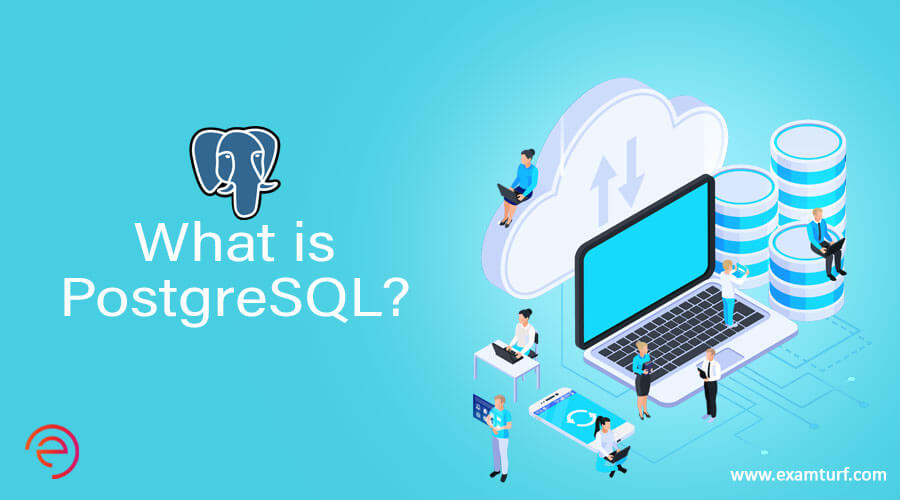
Introduction To PostgreSQL
PostgreSQL generally referred to as Postgres is a relational database management system or RDBMS. It is an enterprise-class that familiarizes itself as an open-source and free database management system that is SQL compliant. Primarily it was referred to as POSTGRES, pertaining to its predecessor, the original one, INGRES database system which was developed at first. It was originally developed in 1996 at the University of California, Berkeley by a group of skilled and expert developers who had made massive and immense contributions to make it a trustworthy database management system. Its name PostgreSQL signifies its immense support for SQL.
What Is PostgreSQL?
1. It is an open-source and free database system, thus it is not controlled by a specific corporation or an entity and it is freely available to be attained by anyone in the open market.
2. When originally developed back in 1996, its initial release was only supported in UNIX and LINUX type platforms.
3. Eventually after several evolutions through time, PostgreSQL now can run in all major operating systems like Windows, MAC, Solaris, and obviously in UNIX and LINUX platforms also.
4. It has been developed by a group of professional who has years of experience in developing database management type platforms.
5. PostgreSQL, being open-sourced and an enterprise version, supports a wide range of operations, from small to big services, like handling of a singular database to database warehousing.
6. It also supports texts, images, videos, audios and also supports a wide range of programming languages like:
- Java
- C#
- C
- C
- JavaScript
- Python
- Perl
- Tcl
- Ruby
What Is The Architecture Of PostgreSQL?
PostgreSQL features a very simple physical architecture. It possesses a shared memory and some background process types. Shared Memory generally refers to the memory which is used for database caching and transaction log caching.
Two of the significant segments of shared memory are:
- Shared Buffer
- WAL Buffer
Shared Buffer are mainly used to minimize disk I/O by following certain rules, which are:
- Minimizing friction among user accesses happening at the same time.
- Access to larger buffers is a requirement to maintain its proper functionality.
WAL buffers are used to store any type of changes that are temporary in the databases. WAL buffers play a vital role in the case of backup and recovery role types.
Secondly, as we mentioned PostgreSQL also consists of a few process types:
- Postmaster Process: when starting the PostgreSQL, it is the very first step and at the beginning, it performs recovery, initializes the shared memory, and also runs background processes.
- The Background Process is the second type which consists of several processes like logger, writer, wal writer, checkpointer, archiver, and stats collector to conduct PostgreSQL operations.
- Backend Process: This is the third one which is used for the user processes to perform query requests and then communicate the results of it.
- Client Process: The final one being the Client process or usually referred to as the background process are allotted generally for all the backend user connections.
Features of PostgreSQL
This enterprise-class database management system has different modern features in its inventory which includes:
- Complicated SQL Queries
- Sub-Queries
- Foreign Keys
- Triggers
- Views
- Table Inheritance
- Advanced Locking Mechanism
- Nested Transactions
- Asynchronous Replication
- Multi-Version Concurrency Control
With new updates and more recent versions, several more features have been added:
- Tablespaces
- A Point in Time Recovery
- User-Defined Data Types
- User-Defined Index and Functional Types
PostgreSQL due to its flexibility is extensible.
Uses Of PostgreSQL
Below are the uses:
- Due to its flexible nature, as mentioned it is used as a powerful back-end database in LAPP (Linux, Apache, PostgreSQL, and PHP) stack which runs many websites and web applications effectively.
- It is highly used in geospatial databases for geographic information systems or GIS using its PostGIS extensions.
- Many big or small organizations use PostgreSQL as their primary database to back-up their applications and software.
- It is also used for analytics, business intelligence.
- It is also used in many financial industries and manufacturing industries.
So these are a few of the many use cases where PostgreSQL plays a vital background role.
Some of the famous companies that have products and applications based on PostgreSQL are Apple, Red Hat, Cisco, Instagram, etc.
Conclusion
PostgreSQL is a modern, updated, and multi-featured relational database management system that performs a wide range of operations or more likely plays a pivotal backend role for many modern-day applications, web applications, and internal and external software products. It acts as the most reliable background storage support for all these apps and products for various private and government institutions.
Recommended Articles
This is a guide to What is PostgreSQL? Here we discuss the introduction, definition, features, uses and what is architecture of PostgreSQL. You can also go through our other suggested articles to learn more –
Are you preparing for the entrance exam ?
Join our Data Science test series to get more practice in your preparation
View More